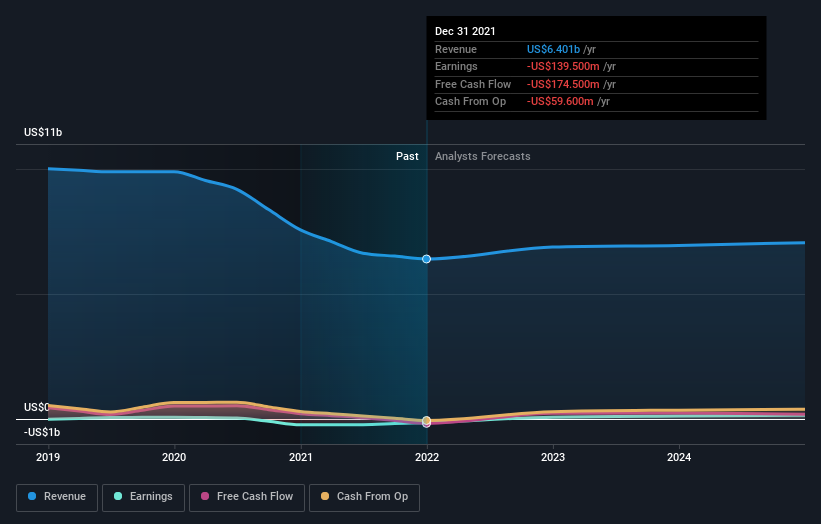Investors five-year losses grow to 70% as the stock sheds US$294m this past week
Statistically speaking, long term investing is a profitable endeavour. But along the way some stocks are going to perform badly. For example, after five long years the John Wood Group PLC (LON:WG.) share price is a whole 73% lower. That is extremely sub-optimal, to say the least. And it's not just long term holders hurting, because the stock is down 23% in the last year. More recently, the share price has dropped a further 28% in a month.
If the past week is anything to go by, investor sentiment for John Wood Group isn't positive, so let's see if there's a mismatch between fundamentals and the share price.
Check out our latest analysis for John Wood Group
Because John Wood Group made a loss in the last twelve months, we think the market is probably more focussed on revenue and revenue growth, at least for now. When a company doesn't make profits, we'd generally expect to see good revenue growth. That's because it's hard to be confident a company will be sustainable if revenue growth is negligible, and it never makes a profit.
In the last half decade, John Wood Group saw its revenue increase by 7.5% per year. That's a fairly respectable growth rate. So the stock price fall of 12% per year seems pretty steep. The truth is that the growth might be below expectations, and investors are probably worried about the continual losses.
You can see how earnings and revenue have changed over time in the image below (click on the chart to see the exact values).
We consider it positive that insiders have made significant purchases in the last year. Even so, future earnings will be far more important to whether current shareholders make money. If you are thinking of buying or selling John Wood Group stock, you should check out this free report showing analyst profit forecasts.
What about the Total Shareholder Return (TSR)?
We'd be remiss not to mention the difference between John Wood Group's total shareholder return (TSR) and its share price return. The TSR is a return calculation that accounts for the value of cash dividends (assuming that any dividend received was reinvested) and the calculated value of any discounted capital raisings and spin-offs. Its history of dividend payouts mean that John Wood Group's TSR, which was a 70% drop over the last 5 years, was not as bad as the share price return.
A Different Perspective
While the broader market lost about 5.4% in the twelve months, John Wood Group shareholders did even worse, losing 23%. However, it could simply be that the share price has been impacted by broader market jitters. It might be worth keeping an eye on the fundamentals, in case there's a good opportunity. Unfortunately, last year's performance may indicate unresolved challenges, given that it was worse than the annualised loss of 11% over the last half decade. We realise that Baron Rothschild has said investors should "buy when there is blood on the streets", but we caution that investors should first be sure they are buying a high quality business. It's always interesting to track share price performance over the longer term. But to understand John Wood Group better, we need to consider many other factors. Consider risks, for instance. Every company has them, and we've spotted 1 warning sign for John Wood Group you should know about.
There are plenty of other companies that have insiders buying up shares. You probably do not want to miss this free list of growing companies that insiders are buying.
Please note, the market returns quoted in this article reflect the market weighted average returns of stocks that currently trade on GB exchanges.
Have feedback on this article? Concerned about the content? Get in touch with us directly. Alternatively, email editorial-team (at) simplywallst.com.
This article by Simply Wall St is general in nature. We provide commentary based on historical data and analyst forecasts only using an unbiased methodology and our articles are not intended to be financial advice. It does not constitute a recommendation to buy or sell any stock, and does not take account of your objectives, or your financial situation. We aim to bring you long-term focused analysis driven by fundamental data. Note that our analysis may not factor in the latest price-sensitive company announcements or qualitative material. Simply Wall St has no position in any stocks mentioned.

 Yahoo Finance
Yahoo Finance 
